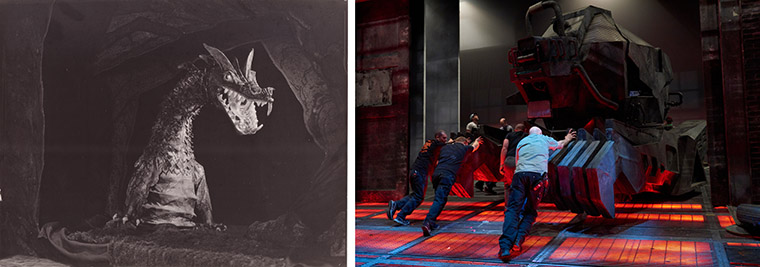Working behind the scenes at San Francisco Opera's The Ring and San Francisco Symphony's semi-staged performances of Mussorgsky's opera Boris Godunov are two remarkable artists who might otherwise not receive the recognition by audiences they deserve.

On the left is the dragon Fafner from San Francisco Opera’s first production of The Ring in 1935. On the right is the modern version of Fafner. For this year’s production, the dragon will be heavily reliant on mobile technology and cutting edge pyrotechnics. Left image:San Francisco Opera Archives. Right image: Photo by Stefan Cohen/San Francisco Opera
BY PAUL DUCLOS
Published: June, 2018
Working behind the scenes at San Francisco Opera’s The Ring and San Francisco Symphony’s semi-staged performances of Mussorgsky’s opera Boris Godunov are two remarkable artists who might otherwise not receive the recognition by audiences they deserve. Indeed, exclusive interviews with SFO’s stage manager and SFS’s director reveal fascinating dynamics underlying both productions.
As Cultural Currents readers know, the last staging of San Francisco Opera’s production of the Ring cycle was seven years ago. Among the more chilling moments of Siegfried was the menacing emergence of the dragon Fafner, rising from its misty lair to confront and challenge our hero.
This year, that episode will be heavily reliant on mobile technology and cutting edge pyrotechnics. But the most vital element contributing to the power of this moment is the close collaboration of several key SFO stalwarts.
John Coleman is the man behind the scenes, coordinating all of the individuals who manipulate the dragon. It’s important to note that the dragon in this production is supposed to look like a machine, whereas in past productions at SFO it looked more like a traditional concept of a lizard-like dragon.
Because this is such a collaborative effort, he credits “Team Fafner” with the outcome. Fafner said he represents “two massive tons of moving scenery.”
The singer—bass Raymond Aceto—rides inside the spinning turret working with a voice reverb, wireless TV and shotgun microphone. The base of the dragon is tethered by a cable and driven by a stagehand who must ensure that it stays on course while moving down a slanted stage.
And then there’s the final confrontation, as American tenor Daniel Brenna challenges the beast with his magical sword. Working with the team’s choreographer is SFO Fight Director Dave Meier, whom we profiled in Bay Crossings in 2016.
“And then there’s the technical director, who manages all the custom-made software,” said Coleman. “And let’s not forget the master carpenter and master technician on the team.”
For more information, see www.sfopera.com.
Symphony to Perform Mussorgsky Opera
Working at the convergence of opera, theater and film, Los Angeles-based artist James Darrah brings together disparate creators and mediums for community-focused collaborations that pair narrative heft and intimate character studies with abstracted, enigmatic realizations of time and space.
Darrah—the man behind the conception of this San Francisco Symphony production of Boris Godunov—said that he expects the performance to surprise and even startle the audience.
“Much of the energy coming from this piece is really organic, and represents the brilliance of its composer,” he said.
“We don’t go into this without a plan, after all. But there’s also some measure of improvisation going on as we work with this brilliant orchestra and Michael Tilson Thomas in a truly collaborative effort.”
Indeed, Darrah said the orchestra is “the central character,” and he builds design values around that entity.
“Your opera company is putting on the The Ring this season, so we are not trying to upstage that event. But the SFS audience may expect a very stirring musical experience from us containing a great deal of emotion and musical force.”
For more information, see www.sfsymphony.org.
Follow Paul Duclos’ Cultural Currents online with his blog at: www.duclosculturalcurrents.com

